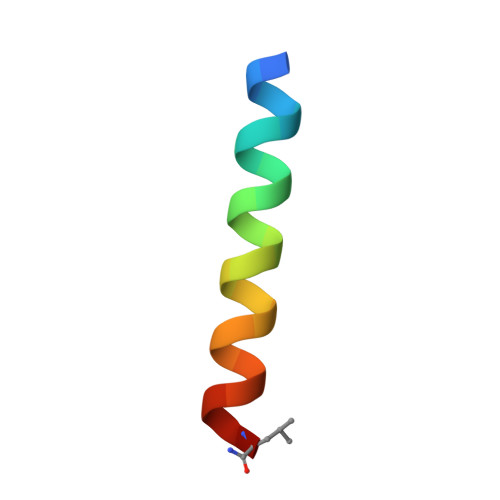High-resolution structures of a heterochiral coiled coil.
Mortenson, D.E., Steinkruger, J.D., Kreitler, D.F., Perroni, D.V., Sorenson, G.P., Huang, L., Mittal, R., Yun, H.G., Travis, B.R., Mahanthappa, M.K., Forest, K.T., Gellman, S.H.(2015) Proc Natl Acad Sci U S A 112: 13144-13149
- PubMed: 26460035
- DOI: https://doi.org/10.1073/pnas.1507918112
- Primary Citation of Related Structures:
4RWB, 4RWC - PubMed Abstract:
Interactions between polypeptide chains containing amino acid residues with opposite absolute configurations have long been a source of interest and speculation, but there is very little structural information for such heterochiral associations. The need to address this lacuna has grown in recent years because of increasing interest in the use of peptides generated from d amino acids (d peptides) as specific ligands for natural proteins, e.g., to inhibit deleterious protein-protein interactions. Coiled-coil interactions, between or among α-helices, represent the most common tertiary and quaternary packing motif in proteins. Heterochiral coiled-coil interactions were predicted over 50 years ago by Crick, and limited experimental data obtained in solution suggest that such interactions can indeed occur. To address the dearth of atomic-level structural characterization of heterochiral helix pairings, we report two independent crystal structures that elucidate coiled-coil packing between l- and d-peptide helices. Both structures resulted from racemic crystallization of a peptide corresponding to the transmembrane segment of the influenza M2 protein. Networks of canonical knobs-into-holes side-chain packing interactions are observed at each helical interface. However, the underlying patterns for these heterochiral coiled coils seem to deviate from the heptad sequence repeat that is characteristic of most homochiral analogs, with an apparent preference for a hendecad repeat pattern.
- Department of Chemistry, University of Wisconsin-Madison, Madison, WI 53706;
Organizational Affiliation:

















